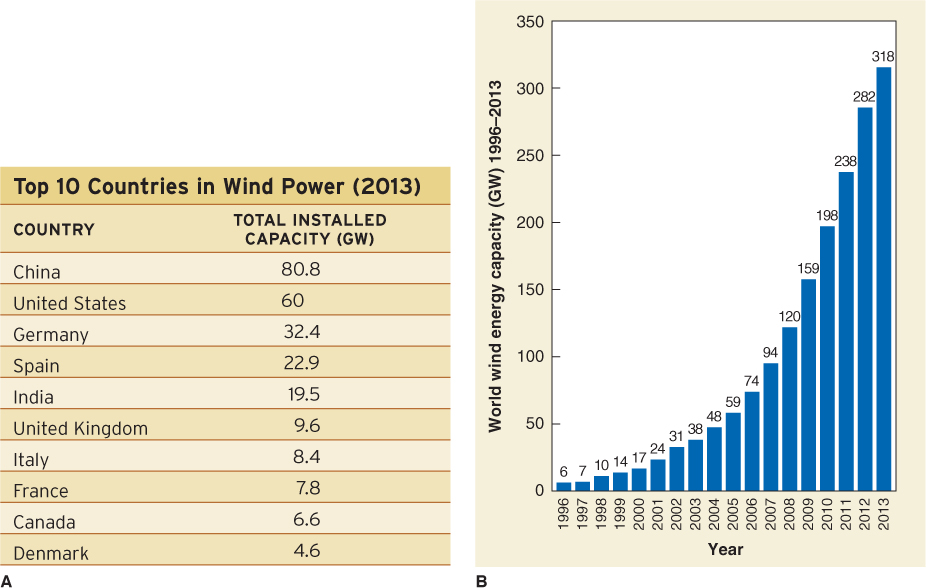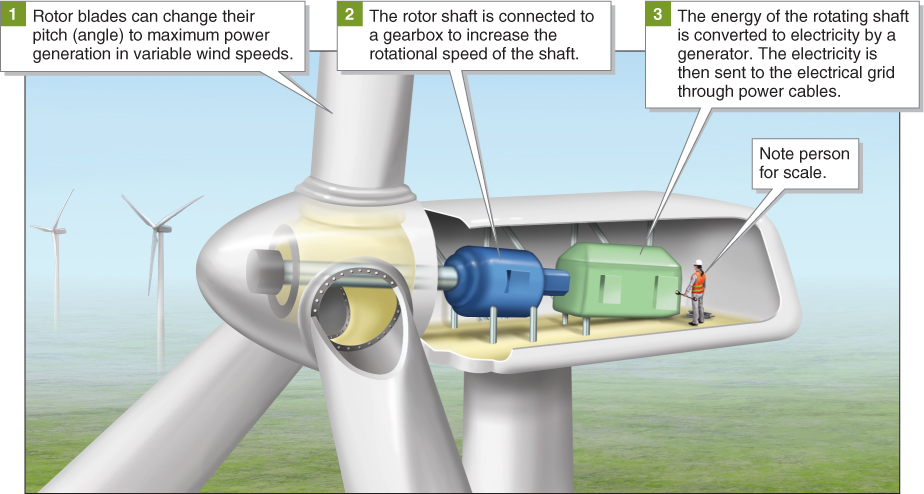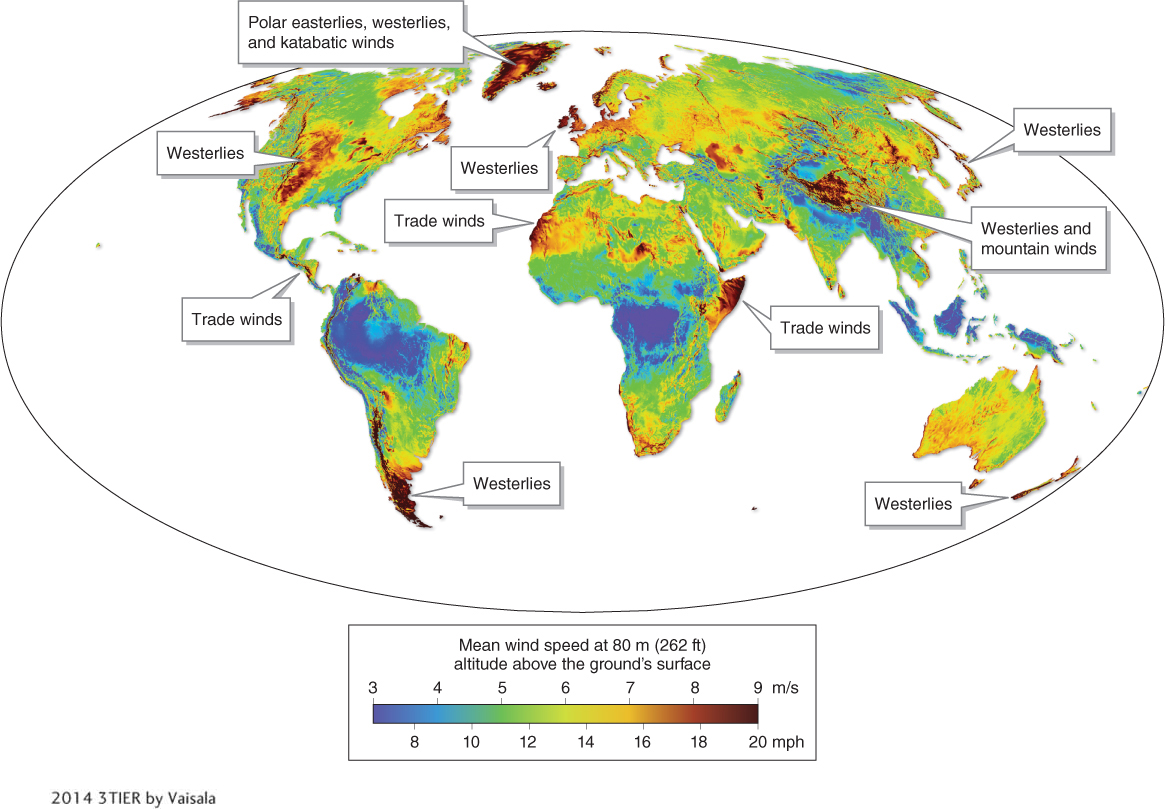4.5 Farming the Wind

Assess the potential of wind as a clean energy source.
Renewable energy sources such as the Sun and wind are inexhaustible and carbon-

In 2013, 3.5% of the world’s electricity supply came from wind. By 2020, it is estimated that this proportion will be nearer to 10%. The United States generated about 4% of its electricity needs from wind in 2013, and the U.S. Department of Energy has set the goal of generating 20% of all U.S. power from wind energy by the year 2030. This will require that the United States build about 100,000 new wind turbines. Can the United States meet the challenge?
There is certainly enough wind energy available for the task. By some estimates, the total wind energy in the Dakotas alone is equivalent to 60% of U.S. electrical demand. But there are several hurdles that must be overcome:
Wind energy must be converted to electricity.
Electrical energy must be moved from where it is generated to where it is in demand.
The electricity must be made available during times of peak demand.
Environmental problems remain to be solved.
Converting the Wind to Electricity
Several different designs and approaches are used to harness the wind’s energy potential. Most wind power designs use turbines, or spinning rotors, which convert the kinetic energy of a moving fluid such as water or air to electrical energy. The wind flows around and moves the rotor blades, causing them to turn a driveshaft to generate electricity (Figure 4.32). The turbines are typically placed atop tall towers to catch the wind.

The Geography of Wind
Not all places are equally windy. Worldwide, the trade winds and westerlies provide an important source of energy (Figure 4.33). The wind does not necessarily blow most strongly where power is most needed, however. In the United States, the consistently fastest winds occur in the Great Plains, an interior region where populations and demand for energy are low.

Offshore coastal areas have abundant wind resources. However, coastal winds are geographically limited compared with winds in the interior of continents, and offshore winds are more expensive to harness because of saltwater corrosion of machinery and adverse marine weather conditions. In addition, frequent political opposition to conspicuous wind power development has curtailed offshore wind projects. Given that political opposition, for the United States to meet its 20% wind capacity goal, most of that wind power will have to be generated from wind farms on the Great Plains because that is where the wind is strongest.
Given its geographic distance from population centers, Great Plains wind power will have to be transported over long distances, which can result in considerable power losses along transmission lines. This problem is being addressed by the modernizing of the U.S. power grid. Once the nation’s grid is improved, moving electricity long distances will likely become increasingly efficient and economically viable.
Storing Wind Power
How can renewable energy sources such as wind meet daily spikes in energy demand in the morning and afternoon? Wind farms that generate power when the wind is blowing must then store it for use when demand is high. This significant hurdle is being dealt with through a variety of techniques and developing technologies.
Hydrogen Storage
When pure hydrogen is combined with oxygen, water is formed, and in the process, usable electricity is produced. Pure hydrogen can be made by separating hydrogen atoms from oxygen atoms in water through a process called electrolysis. Electrolysis uses electricity. The electricity can come from a wind farm.
Hydrogen could be made and transported in its pure gas form from wind farms to populated areas through existing natural gas pipelines that have been converted for hydrogen transport. In all, about 700 miles of pipeline have been converted in the United States.
Hydrogen can also be stored in hydrogen fuel cells, in which pure hydrogen is recombined with oxygen, releasing electricity in the process. This electricity can be used for personal laptops, cell phones, and hydrogen fuel cell cars.
Underground and Reservoir Storage
Underground caverns and mines or large metal tanks can be filled with air using air compressors or pumps. On a windy night, when people are sleeping and wind turbines are generating electricity, air pumps can use electricity to fill these reservoirs with compressed air. The compressed air can then be released at hours of peak energy demand. As the air rushes out of the reservoir through a narrow pipe, it can spin turbines to generate electricity.
Similarly, at night during off-
Environmental Impacts of Wind Power
Two factors that have sometimes stood in the way of wind power development have been the potential of turbines to kill birds and bats and concerns about the effects of wind farms on people who live nearby.
Birds and Bats
Question 4.10
Do wind turbines kill birds?
Each year up to half a million birds are killed by wind turbines.
Rotating wind turbines kill bats, migratory songbirds, and large birds of prey such as hawks. Most bird kills occur through direct collision with the spinning rotor blades. Supporters of wind power argue, however, that these bird kills, while unwelcome, pale in comparison to the birds killed by domestic cats, windows (which birds accidentally fly into), and the other factors summarized in Table 4.2.
|
CAUSE |
YEARLY FATALITIES |
|---|---|
|
Building window collisions |
100,000 to 1 billion |
|
Domestic cats |
365 million to 1 billion |
|
Power line electrocutions and collisions |
100,000 to 175 million |
|
Agricultural pesticides |
67 million to 90 million |
|
Automobiles |
60 million to 80 million |
|
Communications towers |
5 million to 6.8 million |
|
Wind turbines |
100,000 to 440,000 |
|
Source: Nature 486 (2012): 310– |
|
Bat kills by wind turbines are also a problem. According to studies by the National Wind Coordinating Committee, bird kills, on average, are 0.6 to 7.7 per turbine per season nationwide. For bats, the number is 3.4 to 47.5 per turbine. A single wind farm in West Virginia was killing an estimated 4,000 bats each year during the fall migration.
Given the importance of these animals in ecosystems, declines in the numbers of insect-
Wumps and NIMBYs
People who live near large wind farms commonly complain of strange, deep rhythmic pulses, or “wumps.” These complaints have been somewhat successfully addressed with new variable-
Many people want clean, renewable energy, but at the same time, they do not want 130-
The Cape Wind Project, for example, has been waiting for more than 10 years to develop an offshore wind farm in sight of Martha’s Vineyard in Nantucket Sound, off Cape Cod. Its construction was approved in 2013. The $2.5 billion project proposes to develop 130 wind turbines, each 137 m (440 ft) tall from the water’s surface to blade tip. Many wealthy landowners have been opponents of the project. Although they favor renewable energy development, they do not want it marring their views of the ocean.
The Energy Mix
Renewable energy sources such as wind and solar power are dependent on weather, and weather is undependable. All renewable energy sources face this problem of intermittency. The solution lies in a diverse energy mix. By not relying on only one type of energy, but rather creating power from many different renewable sources, we could always have power from one source or another available. Energy from the wind will likely play an increasingly important role in meeting people’s energy needs in the coming decades.